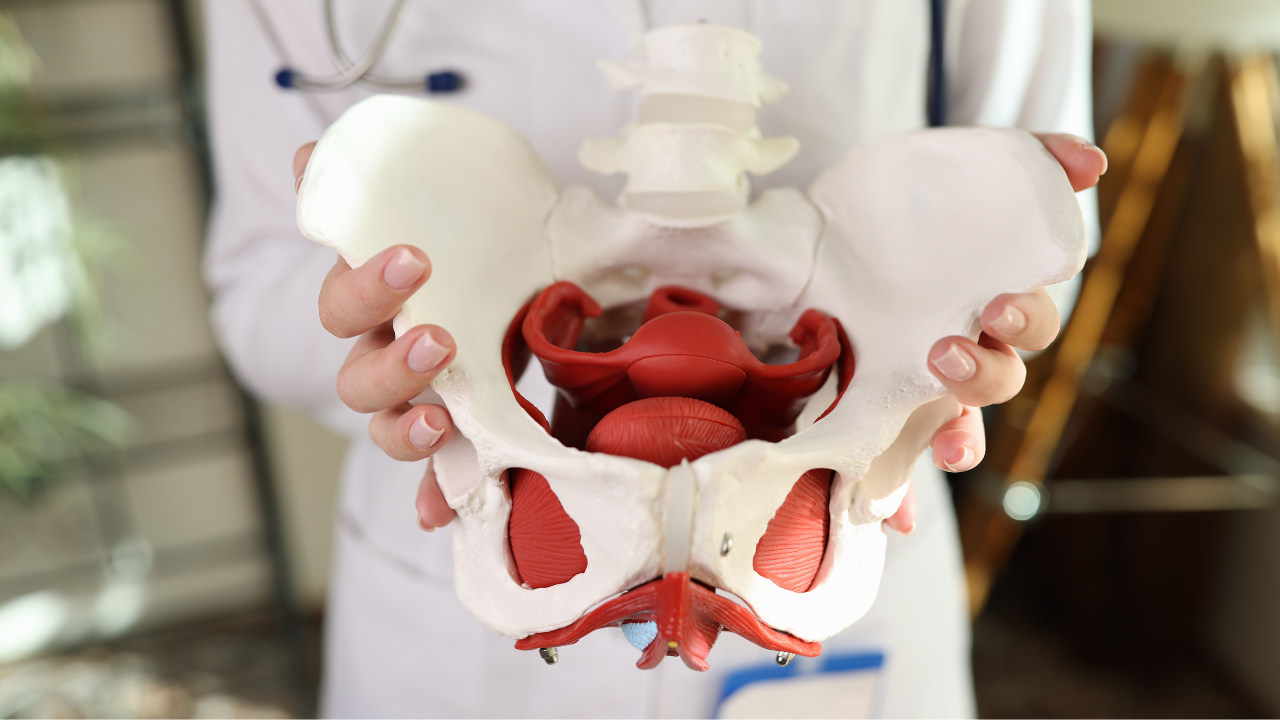The Link Between The Pelvic Floor & Breathing Coordination
Your breath and your pelvic floor are in constant conversation. Every inhale and exhale creates a subtle pressure shift inside your abdominal cavity, linking your lungs, abdomen, and pelvic diaphragm in a continuous rhythm.
At the top of this system lies your respiratory diaphragm, the broad muscle beneath your lungs that moves with every breath. At the base rests your pelvic diaphragm, a bowl-shaped network of pelvic floor muscles. When you inhale slowly, your respiratory diaphragm descends and the increase in abdominal pressure gently lengthens and releases the pelvic floor. As you exhale slowly, both diaphragms rise together, creating a natural recoil and lift through the pelvis.
This dynamic exchange is the foundation of pelvic floor health and postural stability, but it also profoundly shapes how you feel in your body. When your breath can travel freely into your pelvic bowl, it communicates safety to the nervous system, grounding you in presence. When that connection is lost, the body begins to brace and disconnect from its natural flow.
Breathing into this space reconnects your diaphragm and pelvic floor, stabilizing your body from the inside while releasing stored tension that affects how safe and present you feel.
Anatomy of the Pelvic Floor Muscles and Diaphragm
At the base of your body lies a bowl of muscle and fascia known as the pelvic floor. These muscles are not a flat surface but a living hammock, curving and contouring to hold your pelvic organs in place while allowing subtle movement, expansion, and contraction with every breath you take.
The deepest layer of this structure is formed by the levator ani group, a triad of muscles known as the pubococcygeus, puborectalis, and iliococcygeus. They reach from the front of the pelvis near the pubic bone, sweeping backward to the tailbone. Together with the coccygeus muscle, they form a supportive sling that holds the bladder, uterus, and bowel in their proper position. Surrounding these are the smaller sphincteric muscles encircling the urethra, vagina, and anus which are delicate rings that regulate release and pleasure.
Structurally, it acts as a supportive base for the organs above it. In collaboration with the deep abdominal muscles and the multifidus along the spine, it stabilizes the pelvis and lumbar region, giving the entire trunk its integrity and groundedness.
Above this sacred foundation sits the respiratory diaphragm, positioned beneath the lungs and heart. When you inhale, the diaphragm contracts and moves downward, drawing air deep into the lungs. As it descends, the ribs expand outward and the abdominal contents shift gently downward, creating a slight increase in intra-abdominal pressure. The pelvic floor naturally responds by lengthening and softening. It yields to the movement above it, receiving the breath all the way down to the base of the pelvis.
What is Diaphragmatic Breathing/Belly Breathing?
Diaphragmatic breathing, often called belly breathing, is the natural way your body was designed to breathe, a full, three-dimensional expansion that engages the diaphragm, lungs, and deep core in harmony. When you inhale this way, your breath moves downward, expanding your ribs and gently pressing into the abdomen so that the lower lungs fill fully and the belly rises with ease.
In contrast, shallow breathing occurs higher up in the body, restricted to the upper chest or collarbones. The shoulders lift, the ribs barely move, and the diaphragm’s motion becomes limited. This pattern is common when we live in a state of tension or disconnection from the body. Over time, the result is reduced oxygen exchange and a sense of internal tightness.
During diaphragmatic breathing, the motion is expansive and wave-like. As you inhale, the diaphragm contracts and moves downward, allowing the ribs to widen laterally, like the handles of a bucket lifting outward. The lower lungs fill with air, and the abdominal contents naturally shift downward to accommodate this expansion. On the exhale, the diaphragm relaxes and rises back up, the ribs draw inward, and the abdominal organs return to their resting position.
Diaphragmatic Breathing Exercises & Tips
1. Find your resting position
Lie down on your back with your knees bent and your feet planted firmly on the ground, about hip-width apart. Let your tailbone and back ribs sink into the surface beneath you. This position releases unnecessary tension in the hips and spine so your breath can travel freely. Place one hand on the lower edge of your rib cage and the other just below your navel.
2. Inhale slowly through your nose
Draw the air in through your nose and feel it expand into the lower lungs. Your rib cage should widen and your belly gently rise into your palm. Notice how this gentle increase in intra-abdominal pressure invites your pelvic floor to lengthen and descend, a subtle yielding deep in your pelvis, like a hammock stretching with the breath.
3. Exhale slowly through your mouth
Let the breath leave through slightly parted lips, as though you’re sighing. Feel your ribs draw inward and your abdomen ease back toward your spine. As the diaphragm relaxes and rises, the pelvic floor naturally lifts, following the breath upward. This movement should feel like a light gathering of energy at the center of your pelvis.
4. Stay relaxed - avoid bracing or holding
Notice if you’re gripping your abdomen, tightening your thighs, or holding your breath at the top of the inhale. Those habits interrupt the pressure flow within the abdominopelvic cavity and prevent the pelvic diaphragm from moving freely. Keep the abdominal muscles soft enough to allow expansion, and focus on slow, continuous breathing. The breath should move like water, being fluid and effortless.
5. Continue for 5–10 minutes
As you settle into this rhythm, feel the gentle wave of pressure moving from the diaphragm to the pelvic floor and back again. With each cycle, the tissues of the pelvis begin to soften and awaken. Over time, this pattern retrains the pelvic floor muscles to release when the body inhales and to support when it exhales.
6. Bring this breath into daily life
Once this flow feels natural, explore pelvic breathing beyond the mat. Practice while sitting upright, standing, or moving through gentle yoga or squats. Notice how the direction of gravity changes the sensation of the breath.
Online Memberships and Courses for Pelvic Health


For women ready to go deeper into the practice of pelvic awareness and embodied breath, The Empowered Woman offers online memberships designed to support your journey. You’ll learn how to cultivate presence in the pelvis and how to consistently and consciously send your breath into this space.
Our Healing Vaginal Pain Course is specifically created for women experiencing discomfort or pain in the pelvic space. It blends gentle somatic practices, breathwork, and education to reclaim comfort and ease where it may have felt lost.
For women who are ready to go into deeper self-connection, Viva La Vagina 2.0 offers the ability to explore your sensual and erotic embodiment. This course guides you to reconnect with your pussy as a living, breathing part of your being.
Each program guides you from holding into flow.
Common Breathing Patterns That Harm Pelvic Floor Health
1. Breathing only into the upper chest
When the breath stays trapped high in the chest, the diaphragm hardly moves and the pelvic floor, which mirrors its rhythm, stops moving too. The result is a subtle but constant gripping in the base of the body. Over time this can show up as tightness or aching in the pelvis, and a general feeling of being “held up” rather than supported from within.
2. Constantly “holding the core”
Many women have been taught to suck in the belly for good posture or to keep the core “engaged.” But when the abdomen is habitually pulled in, there’s nowhere for the breath or the internal pressure to go except downward. The pelvic floor ends up bearing the brunt of that pressure. True strength comes from responsiveness and a core that moves with every inhale and exhale, expanding and gathering naturally.
3. Holding the breath in effort, intimacy, or stress
Notice what happens when you lift something heavy, have an orgasm, or brace against pain, do you stop breathing? Breath holding is the body’s instinctive way of creating control, but it also traps pressure inside the abdomen and pushes down on the pelvic organs. Over time, this pattern can strain the pelvic floor and make it harder to relax or feel pleasure.
Breathing with Your Yoni Egg
I believe a yoni egg is one of the most direct and practical tools for becoming aware of how your breath affects your pelvic floor. It works by giving you physical feedback and a point of contact you can actually feel moving inside your body as the muscles respond to your breathing.
As you breathe in, the egg may feel as though it settles or drops slightly which is a sign that the pelvic floor is softening and yielding to the inhale. As you exhale, you may sense the egg rising or being gently gathered upward showing that the muscles are naturally recoiling and supporting from below.
This simple feedback loop makes something that’s usually invisible suddenly tangible. Many women are surprised to discover that their pelvic floor hardly moves with the breath at all. The egg also helps them identify where movement is restricted or where the muscles are underactive.
If you tend to grip or brace, you’ll feel how the egg barely shifts as a sign that the pelvic floor isn’t releasing on the inhale. As you practice breathing more deeply into your belly and sides, the egg begins to move more freely, teaching your body that it’s safe to let go.
Sexual and Emotional Dimensions of Pelvic Breathing
The breath governs what we feel and what we can release. Nowhere is this more tangible than in the pelvis, and the quality of your breathing directly determines how alive this part of you feels.
When the breath is shallow the diaphragm barely moves. Without that downward motion, the pelvic floor also becomes still. When something has been painful or unsafe, it closes to minimize sensation. Over time, that guarding becomes habitual, so even in safety, the body doesn’t know how to let go.
When you begin to breathe fully again, the diaphragm descends on each inhale, and gently increases pressure within the abdomen, which encourages the pelvic floor to lengthen and spread. The muscles at the vaginal opening, perineum, and lower belly respond to that internal movement like soft fabric being stretched. On the exhale, the diaphragm lifts and the pelvic floor recoils naturally, gathering tone without force. This rhythmic movement of expand, return, expand, return is the body’s original language of regulation and repair.
Pain often comes from muscles that are overactive and shortened, doing the job of protection long after it’s needed. Breathing into the pelvis reminds these muscles how to trust movement again. As circulation increases, arousal becomes easier and more embodied. Breath becomes the rhythm that carries pleasure throughout the body where you inhale to open and receive and exhale to draw sensation upward through the spine and heart. This natural rise of energy is what ancient traditions called the movement of life force energy, or jin.
FAQ
-
Does the pelvic floor affect breathing?
Yes and you can feel it when you start to pay attention. Your pelvic floor muscles and your breathing diaphragm form the top and bottom of the same internal space, the abdominopelvic cavity. Every time you inhale slowly, the diaphragm contracts and moves downward, creating a gentle increase in intra-abdominal pressure. When that happens, the pelvic diaphragm, the sling of muscle at the base of your pelvis, naturally responds by lengthening and widening.
-
How should I breathe during pelvic floor exercises?
The best breathing technique for the pelvic floor is one that feels slow, full, and responsive, not forced. Try beginning in a resting position, lying on your back with your knees bent and your feet grounded.
As you inhale slowly through your nose, feel your rib cage widen and your belly expand. Imagine the breath traveling all the way down to your pelvis, the abdominal contents shift gently downward, and the pelvic floor muscles spread and release. On your exhale, the diaphragm moves upward, the lower ribs draw inward, and the deep abdominal muscles and expiratory muscles engage just enough to create a light, natural lift through the pelvic floor.
This rhythm, inhale to soften, exhale to gather, restores pelvic floor muscle function without strain. Avoid breath holding or bracing the upper abdomen; instead, let the breathing pattern move through your whole trunk. Over time, this kind of belly breathing helps to reduce pelvic pain, support urinary incontinence treatment, and improve overall pelvic health by bringing strength and suppleness back into the tissues.
-
What are the symptoms of a tight pelvic floor?
A tight or overactive pelvic floor often feels like a body that can’t fully exhale. The muscles surrounding the vagina, anus, and urethra stay slightly contracted all the time, as if holding in a breath that never releases.
Common signs include pelvic pain, burning or aching in the lower pelvis, pain during sex, difficulty inserting tampons, or a feeling of tension or fullness that never goes away. Some women also notice urinary urgency, constipation, or straining which are all signs that the pelvic floor muscles are doing too much.
This often develops from chronic stress, abdominal bracing, or shallow breathing that keeps the diaphragm frozen in the upper chest. The body stays on alert, and the pelvic floor mirrors that tension.
Diaphragmatic breathing exercises are a powerful way to reverse this. When you breathe slowly and allow the diaphragm to move through its full range, it sends a clear signal of safety to the nervous system. The pelvic floor muscle can then relax, receive blood flow, and regain flexibility. Over time, this helps ease pressure and restore the natural rhythm between breath and body.
-
Should the pelvic floor lift with every exhale?
Yes, but it’s meant to be subtle, not something you do. As you exhale slowly, the diaphragm relaxes, the lower ribs narrow, and the deep abdominal muscles engage lightly. This creates a natural upward support through the pelvic floor, helping the pelvic organs stay buoyant and stable.
If you feel yourself actively squeezing or forcing the lift each time you exhale, that’s too much effort. A healthy breathing pattern is fluid: the pelvic floor and diaphragm rise and fall together, the lumbar spine stays supported, and the abdominal pressure remains balanced.
When this coordination returns, you’ll feel more grounded and spacious at once. Your breathing exercises will not only support pelvic floor health, but also improve postural control, trunk stabilization, and even blood pressure regulation. In this way, deep breathing becomes both an exercise and a way of living, a quiet, daily conversation between your lungs, your pelvis, and your sense of ease.









Pelvic floor muscle spasms in men are more common than most realize. This guide explains what triggers pelvic floor dysfunction and ways to relieve chronic pelvic pain.